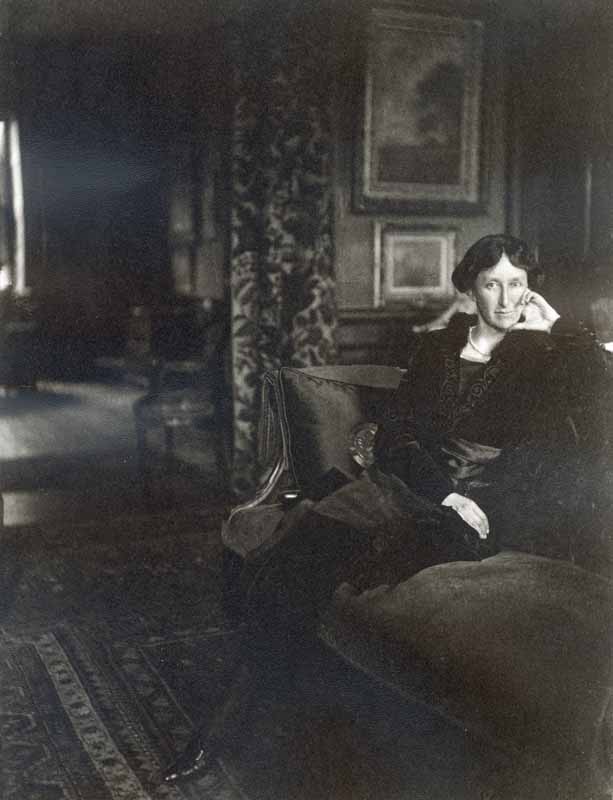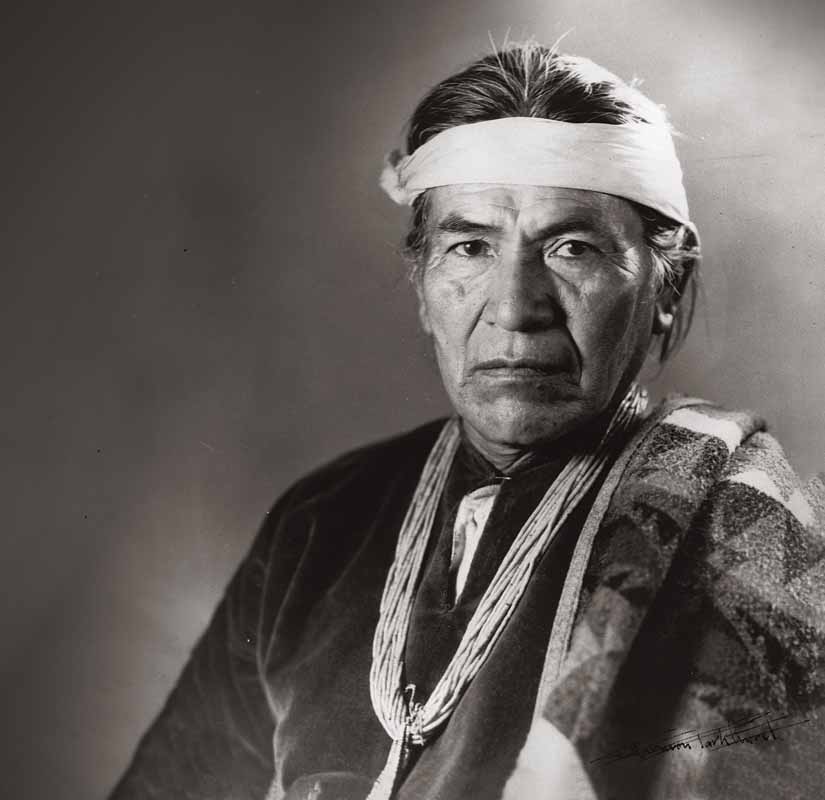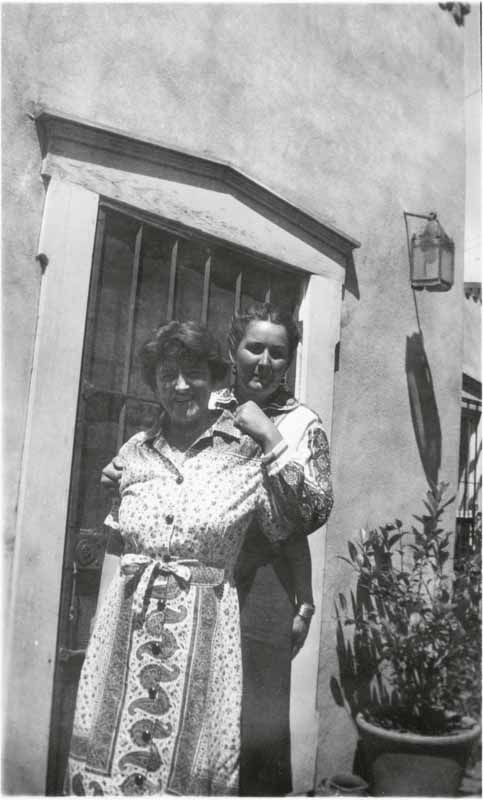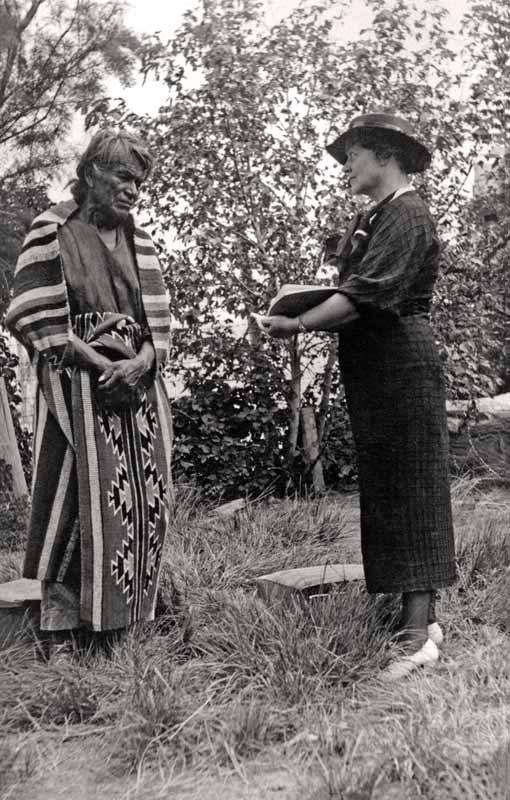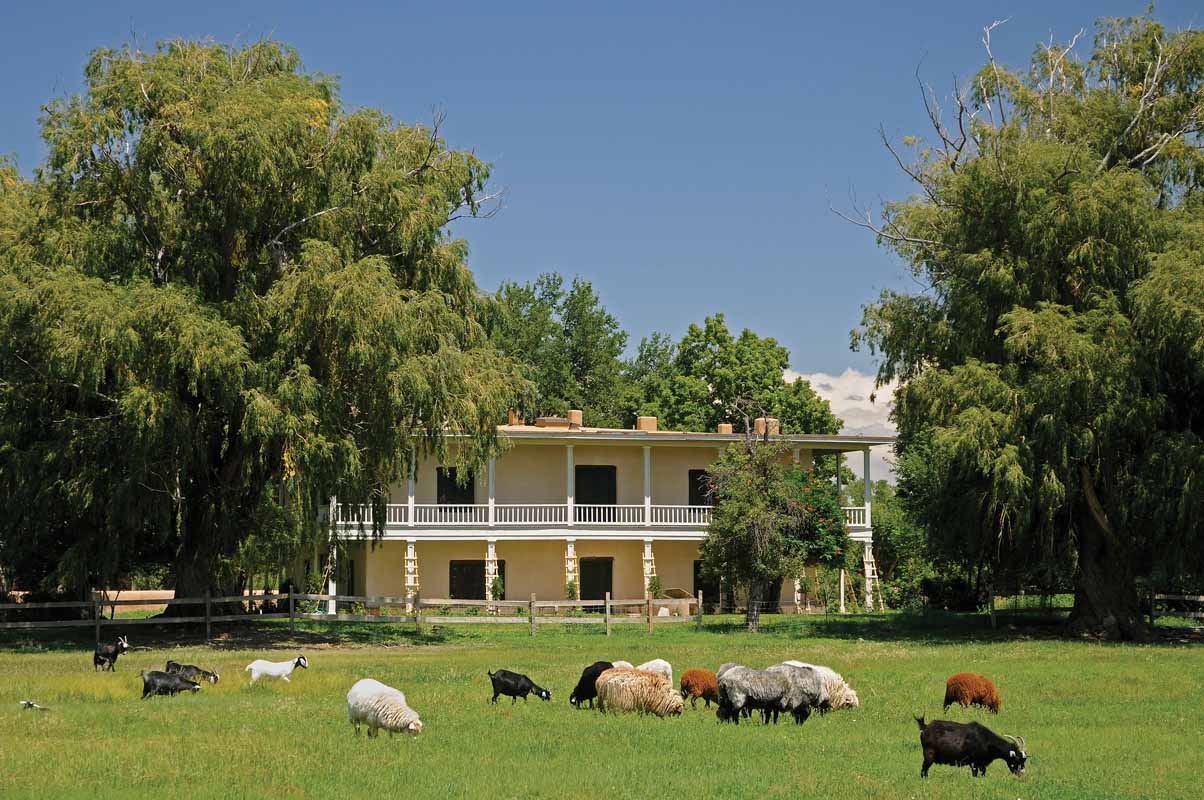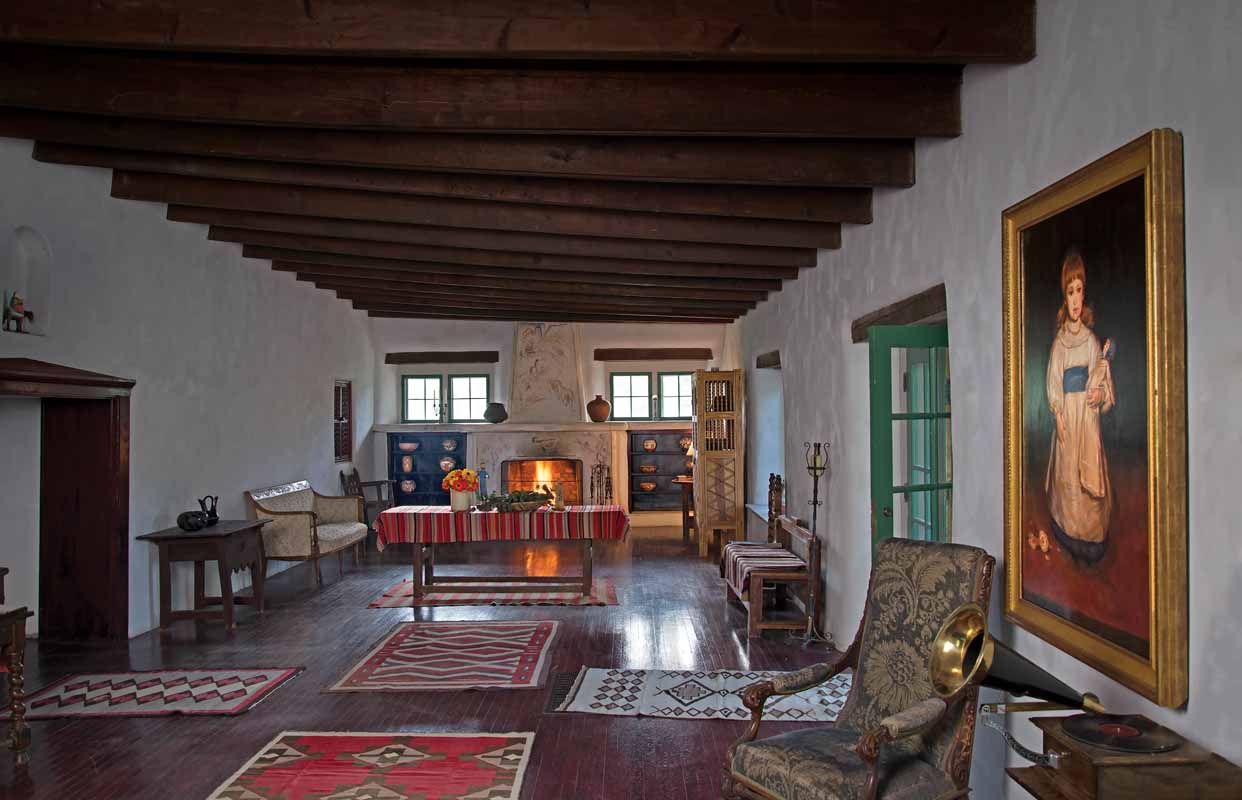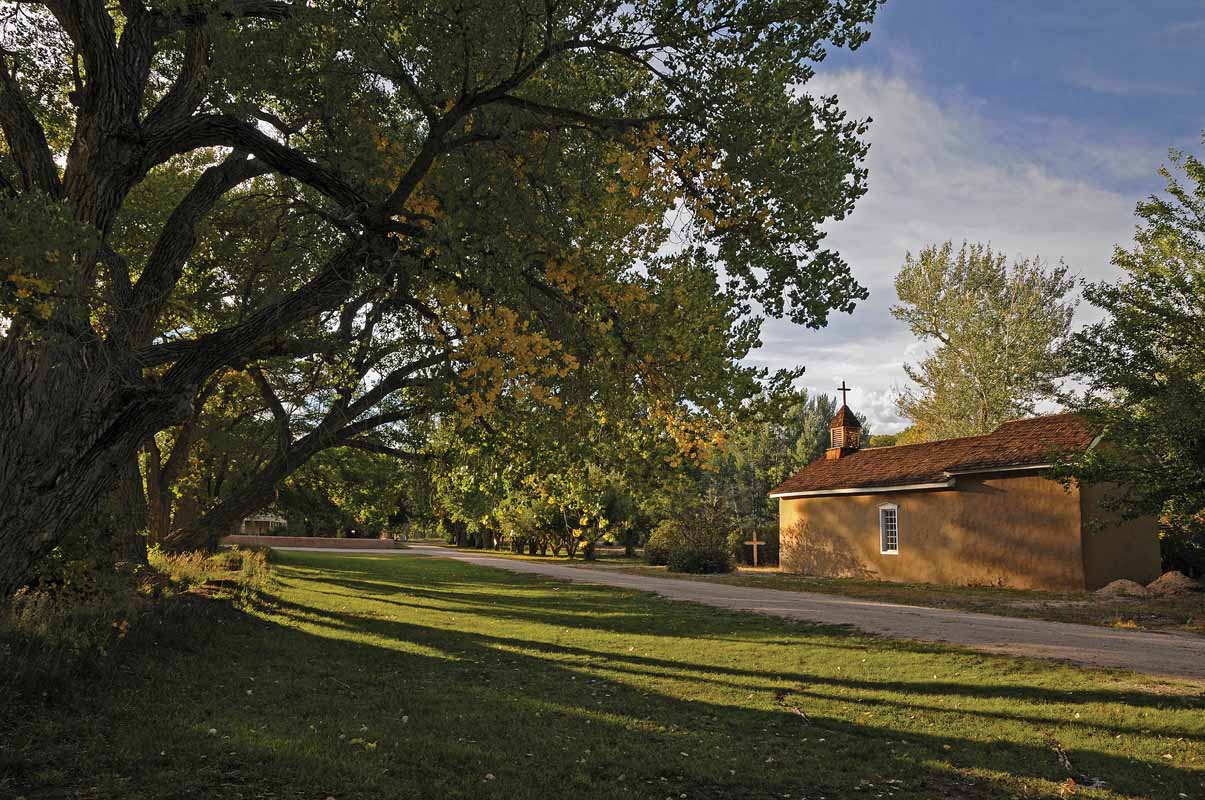Spinster Acts
Reweaving queer history into New Mexico’s origin stories.
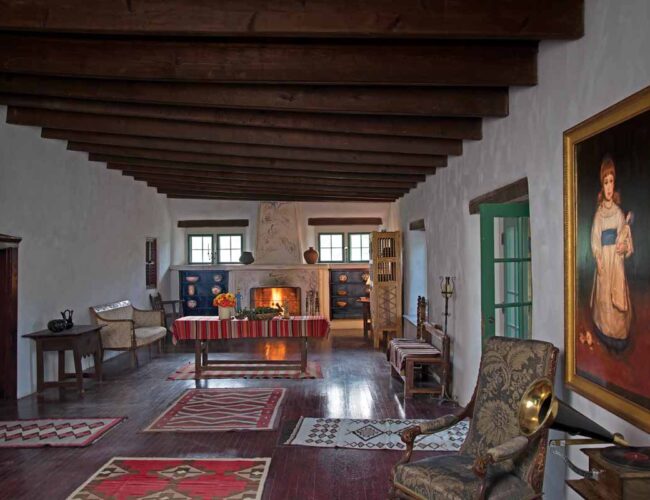 A recent photograph of Casa Grande's
Grand Sala. The fireplace features paintings by Olive Rush, and Mary Wheelwright's childhood portrait is on the right. Photograph by Gene Peach.
A recent photograph of Casa Grande's
Grand Sala. The fireplace features paintings by Olive Rush, and Mary Wheelwright's childhood portrait is on the right. Photograph by Gene Peach.
BY ETHAN ORTEGA
On March 28, 2019, Governor Michelle Lujan Grisham signed legislation designating Los Luceros (formerly a Historic Property) as a State Historic Site, thus securing funding, staffing, and preservation of the site in perpetuity. As a result, Los Luceros and its complicated history were thrust into the limelight and embraced by its visitors.
But we at New Mexico Historic Sites were not unprepared. In 2018, I was asked by Director Patrick Moore to design and implement interpretive programming for the Los Luceros Historic Property. Along with expected historic narratives—the ancestral Tewa people, the arrival of the Spanish with themes of colonialism, conflict, and contested space [see El Palacio’s fall 2017 feature “The Secret Sanctuary”]—an unexpected theme began to emerge: I learned that certain Los Luceros residents in the early twentieth century defied cultural norms in terms of gender, identity, and sexuality.
Mary Cabot Wheelwright spent the first forty years of her life as a dutiful daughter and philanthropist. After the death of her parents, the heiress abandoned East Coast upper-class society to seek a self-determined life out West. Wheelwright visited the Alcalde area in 1918, and eventually became the catalyst for the twentieth-century queer history of Los Luceros. By 1931, she had purchased all of what is now Los Luceros Historic Site and began resurrecting the property and restoring the Casa Grande as a vacation home. There is no documentation that Wheelwright’s sexuality strayed from cultural norms at the time; however, there is clear evidence that her gender expression did. After establishing roots in New Mexico, Wheelwright publicly embraced roles considered to be both masculine and feminine, stating that “it was possible to be a good sport and also drink tea.” During this time, she surrounded herself with progressive thinkers such as artists, activists, intellectuals, and preservationists.
After purchasing a weaving by Hastiin Klah in 1921, Wheelwright developed a friendship with the artist. Klah is revered as an influential Navajo artist, healer, and cultural preservationist. As a teenager, Klah was recognized as Ná’dleehí, which is a third-gender or non-binary term used by the Navajo. Another friend, Frances Newcomb, described Klah by saying, “The Navahos [sic] believed him to be honored by the gods and to possess unusual mental capacity combining both male and female attributes. He was expected to master all the knowledge, skill, and leadership of a man and also all of the skills, ability, and intuition of a woman. Klah, during his lifetime, lived up to these expectations in every way.” Between 1931 and 1937, Klah visited Los Luceros regularly and collaborated with Wheelwright to create a museum focused on documenting and preserving Navajo culture. The Santa Fe museum they created together, still in operation today, and is now known as the Wheelwright Museum of the American Indian. As a Ná’dleehí individual, Klah was able to provide a perspective encompassing both male and female cultural traditions.
Another notable character in this group was Maria Chabot, a photographer, writer, and explorer from San Antonio, Texas who went on to catalyze what is now the Santa Fe Indian Market. Chabot’s exposure to New Mexico, and eventually to Los Luceros, was the direct result of her intimate relationship with artist Dorothy Stewart. In 1933, Chabot met Stewart in Mexico, where she was pursuing her interests in art and literature. The two lived together much of the next decade in Santa Fe on Canyon Road, and traveled the world visiting the Americas, Europe, and Africa. During this time, Chabot became a familiar face in the progressive circles of Santa Fe, and met many influential individuals, including Wheelwright.
After a torturous breakup with Stewart in 1939, Chabot began working for the New Mexico Association on Indian Affairs and was offered refuge at Los Luceros, where she began rebuilding her life without Stewart, serving as the property’s farm manager and Wheelwright’s companion. At a mid-October luncheon hosted by Mary at Los Luceros’ Casa Grande, Chabot was introduced to Georgia O’Keeffe.
This introduction led to an intense decade-long relationship, one that encompassed Chabot’s work as a project manager for O’Keeffe’s Abiquiu house restoration as well as the honcho for and companion on their camping trips to the Bisti Badlands (O’Keeffe called it the Black Place), where the artist painted some of her best-known works. The interactions pushed the boundaries of employee/employer and friend/lover. This relationship is documented by over seven hundred letters in Maria Chabot—Georgia O’Keeffe: Correspondence, 1941–1949 (University of New Mexico Press, 2003), which reveal Chabot’s obsessive desire to be close to O’Keeffe and her insecurity within the relationship. The letters also reveal O’Keeffe’s encouragement, as well as desire for autonomy and self-determination. By the fall of 1949, around the time of the completion of the restoration of O’Keeffe’s Abiquiu house, the two were no longer in regular contact.
To begin publicly supporting and exploring Los Luceros’ untold queer history, New Mexico Historic Sites, New Mexico Humanities Council, and Friends of History scheduled a related panel discussion at the Explore Los Luceros history symposium in spring of 2019. I moderated that conversation, with panelists Rapheal Begay, Alicia Inez Guzmán, and Hannah Abelbeck on May 25.
Although the panelists come from diverse backgrounds (Diné, Hispanic, and Anglo, respectively), they do not represent everyone from those groups. Their responses have deep roots in each of their personal lived experiences and are molded by their identities. It is also important to keep in mind that when discussing a queer framework for studying the past, the identity categories that we use today, such as LGBTQ+, were not used in the late nineteenth and early twentieth centuries. Finally, the goal of this panel was not to present a queer history limited to Los Luceros. Our goal was to initiate broader discussion of queer history in the Southwest, and to work towards ending the missed connections and censorship of queer history presented at museums and historic sites.
+ + +

Ethan Ortega: I’m from Portales, New Mexico, and I identify as a queer Hispanic man. I have a B.S. in anthropology from Eastern New Mexico University, and an M.S. in museum studies from the University of New Mexico. I currently serve the people of New Mexico as an instructional coordinator and archaeologist for New Mexico Historic Sites. I am starting my sixth year with the division, and I enjoy challenging the historical narratives that have been promoted in our museums and sites for decades. I believe that history is fluid, and our future will benefit from an equitable multi-perspective interpretation of the past

Hannah Abelbeck: I’m the photo archivist in the Palace of the Governors Photo Archives at the New Mexico History Museum. I’ve spent a lot of time looking into the past, but ultimately through other people’s choices. I enjoy interdisciplinary work, and bringing primary sources to new audiences. Originally from Nebraska, I’ve lived in New Mexico for about six years.

Rapheal Begay: Yá’át’ééh. Shí éí Rapheal Begay yinishyé. Honágháahnii nishłi˛. Kin łichii’ nii bashishchiin. Tábaahí dashisheii. ‘Áshi˛i˛hí dashinalí. Hello, my name is Rapheal Begay. My mother’s clan is One Who Walks Around. My father’s clan is Red House. My maternal grandfather’s clan is Water’s Edge. My paternal grandfather’s clan is Salt. I’m from Window Rock, Arizona, but am originally from Hunter’s Point, Arizona, where my mother and grandmother originate. My father’s side of the family is from Coyote Canyon, New Mexico. For the last year, I’ve worked for the Navajo Nation Division of Human Resources. I work directly with our division director, who is part of the cabinet for the administration of President Jonathan Nez and Vice President Myron Lizer. I’m an independent photographer and curator focused on Indigenous, queer art and culture. In addition, I’m the social media director and a board member for Diné Pride, which is in its third year.

Alicia Inez Guzmán: I’m from Truchas, New Mexico. I’m a Trucheña, a Chicana, Chingona, currently senior editor of New Mexico Magazine, and I hold a Ph.D. in visual and cultural studies from the University of Rochester. My writing and editorial work focus on complex histories of land use, on artists of color, and queer artists of color. I’m always trying to lift up different kinds of voices into public spaces. It is my goal as an artist, writer, editor, and curator.
Ortega: What does the term “queer history” mean to you?
Begay: We don’t speak for everyone, but for ourselves and our own lived experiences. I identify as a gay cis male. As far as being queer, I’ve always looked at it as alternative, a bit more radical and rebellious and forward-thinking. I see queer history as an alternative history: a history that is not necessarily at the forefront in mainstream culture or academic scholarship. I believe queer history to be open to its own narrative and intent. For me, intent means everything; it goes a long way. The intent within and of queer history must be uncovered, explored, navigated, and celebrated.
Guzmán: As a queer woman, I’m constantly remaking my identity. We can say the same thing about the past: We are constantly rethinking and remaking the past and how we can talk about it. In many cases, the public record isn’t going to reveal a lot about queer history because that history may not have made it into an archive. There are instances where you might hear of an unmarried relative, but you don’t know whether that person was queer. It’s hard to retroactively apply identity terms to the past because they can be so categorical. We remake ourselves and our identities, and over time those terms can change. We can change them ourselves, they can be changed by others. We can talk about the past, but we are always limited in how we do so, especially when it comes to queer history.
Abelbeck: I also identify as queer. I think that one reason I do is that I’ve always been confused about what other people expect of me, and what I expect of myself. Expectations are part of how everyone interacts with gender roles, and I think that becomes very interesting when you look across time and when you look across cultures. I think using a queer framework to look at the past can be helpful. Not just with the type of people that we today would recognize as queer, but with all of the people in the past who struggled with their societies’ expectations about gender: about how people should behave, about how you should form families or maintain relationships. That is one reason it could be very valuable to talk about queer history, no matter who the subject of your inquiry is.
Ortega: Why is queer history so hard to research?
Abelbeck: One of my interests is the networks of unconventional women in northern New Mexico during the twentieth century. Maria Chabot was part of that scene. But these women’s intimate relationships can be very difficult to talk about. Although these women were everywhere, the records of their lives are highly censored, often by themselves and those closest to them. Sometimes the colorful parts of their stories only survive tangentially, or through gossip or rumor. Many of these women lived their lives in such a way that publicly they were indistinguishable from other women of their class and circumstances. They looked exactly like other spinsters, suffragettes, career-minded women, bohemians, or women who got divorces and so on, even if they lived openly among their friends. The queer narrative is lost, hidden, scattered, and inconsistent. While this documentation problem is acute for queer white women, archival records prove very difficult for fairly capturing the lives of women and minorities in general. Many people’s stories aren’t documented, while others have carefully curated records. Many people who lived extremely interesting lives don’t have their records in archival repositories, and thus aren’t written about.
Guzmán: History is and was gendered—typically from a male perspective—and most archives are very white. That is incredibly limiting if you want to try and get any other kind of perspective. Before a lot of white women moved to the area, existing cultures here were already dealing with or living in prescribed gender identities. The limitations of telling queer histories include finding those histories, because often people conflate having respect for historical figures with avoiding queer identification or conjecture, or, as in Hispanic communities, oral histories are often censored when talking about a relative who might not fit a gender norm. The History (with a capital H) of various cultures that were already here in New Mexico, moreover, has usually been written from the point of view of an Anglo, anthropological gaze. As a result, histories are often very one-sided. An example is Matilda Coxe Stevenson’s nineteenth-century account of a person called “Zuni Man-Woman,” or We’wha (1849–1896), a Pueblo person who, of course, did not prescribe to American and Victorian gender expressions. We’wha was written about extensively from outside perspectives, including in Matilda Coxe Stevenson’s writing on the Zuni [The Zuni Indians: Their Mythology, Esoteric Fraternities, and Ceremonies].We have to continually acknowledge where writing is coming from, and what role privilege plays in why those stories are preserved in “public” records. This also doesn’t mean that certain communities don’t have private ways of engaging their own histories.
Begay: Regarding queer scholarship and inquiry within history, I often wonder: What is the intent of wanting to view these narratives, these facts and points of view? Sure, we can look at it in terms of making those histories known. Or is it merely wanting to probe, or to make sense of history? For so many who live in the rural Southwest, there is but a gas station and the landscape, with limited to no resources for queer individuals and communities. And so, how does one feel, embody, or express their queerness? I wonder if those who lived in the past were here to speak for themselves, would they give two fucks about what we think or how we understand their history? As we continue to create our own, we must remain aware of our ability to express our hopes and dreams while contributing to the lexicon of queer history and future.
Ortega: To what extent do you think people in the early twentieth century in New Mexico could be themselves?
Guzmán: When white women from the East Coast came here, what they could do was different from what anyone else could do because of their privilege. For these people, the West was a place where they thought they could be their “authentic” selves. But the narrative of authenticity is problematic, because not everybody gets to experience authenticity in the same way. It is a privilege. Advertising slogans like “Find yourself in the West” suggests that a person would be able to tap into their prelapsarian self. People who were already here lived under a whole other code of operation and had other ways of talking about who they were. For Hispanic people, the ability to live a specific way outside of the social norm could be more limited than the ability of anyone else who comes here.
Ortega: Can you talk about how silence in local communities regarding identities and acceptance?
Guzmán: I think silence operates in a lot of different ways. There is silence in archives. There is the silence of calling somebody a “friend.” There are all sorts of ways to skirt a topic. You could be not talking about something because it offends you, or because you are trying to protect somebody. The codes of silence operating in different families, for instance, could enable somebody to live have a different gender identity or orientation without suffering repercussions in the community. Silence could work to protect, to not acknowledge, or do all those things all at once.
Begay: The use of the term “friend” in my community, for example, “shí fran” (my friend), demonstrates an attempt by others to recognize who you as a queer person want in your life. It is sort of like, “I will give you just enough recognition to let you know that I’m aware of the situation, aware of your lifestyle, and aware of your desires.” But it also chooses to ignore the exact thing you are trying to make known. It is an interesting thing to introduce your partner to your family. I recall stating: “This is my boyfriend.” Instantaneously, my mom turned around and introduced him as my “friend.” It was a very quick decision on her part, as there was a certain amount of comfort in relabeling him as my friend. As such, I consider comfort to be a very dangerous thing, because at that point it is not intended to connect, communicate, or explore; it is silence.
Ortega: How do you think things have changed, in terms of all of these themes, from the early 1900s to today? What would you like to see change as we talk about queer history, moving forward?
Abelbeck: I sometimes think that the change in queer lives is a little less drastic than the changes in everyone’s lives, especially in terms of people’s expectations about marriage and families. A lot of things have changed drastically since the turn of the twentieth century. It is not like Stonewall just happened randomly and things changed; many historians see it as a part of a broader picture—an event caused by and a cause of changes in the twentieth century that, in turn, changed all of us. I would like to see us have a broader, more nuanced understanding of the past that can open up some of the really stagnant ways that things like tradition get evoked when taking about reproductive rights, marriage, or a number of other topics. A better understanding of the past and differences in the past should be helpful with some of the questions and decisions we have today.
Guzmán: My vision for the future is self-determination: people telling their own stories and having control of their own bodies. For those who aren’t in a record, and therefore may not exist in a historical context, they can’t gain self-determination retroactively, but we can continue to honor the past. How do we tell our own stories, how do we imagine, how do we make those stories so that everyone can see them, so that we are not alienating each other, but we are allies in the same space, and we are not enabling or entitling one narrative over another? We have a lot of work to do. Let’s all be good storytellers. Let’s all enable others to tell their stories as well.
Begay: I would like to add personal responsibility. I think that is lacking in the communities that I currently live in and have the privilege of being a part of. But also, in art. With self-determination in mind, we have a personal responsibility to be decent human beings with a will to understand. Be personally responsible for yourself, your history and your culture. We are all able and must be willing to create our own destiny and actively contribute to our own narrative. Within that, allow others to have their moment and their own existence; an existence that you can’t necessarily imagine for yourself. I say it every day: I’m ready for the future. Sometimes the world isn’t, and for me that is okay. It is with intent that things have changed and will continue to change, as we are all a part of history. We are sacred.

